Wrapped in Nine Yards of Strength and Story
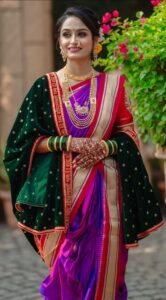
The Nauvari saree is not just about how it looks — it’s about how it moves, transforms, and empowers. For centuries, this nine-yard marvel has defied the limitations of “traditional wear.” Instead of wrapping around a woman, it walks with her — from battlefields to temples, from stages to streets. It’s a saree that doesn’t whisper tradition — it commands it.
What Exactly Is a Nauvari?
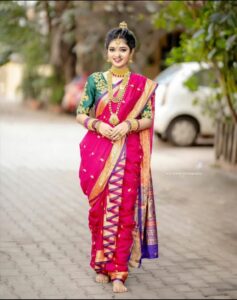
The word Nauvari literally means “nine yards.” That’s the length of this iconic saree. But it isn’t just about the fabric — it’s about function and freedom.
Unlike the more common six-yard saree, the Nauvari is worn like a dhoti. Women step into it and tie it at the waist, with one end pulled between the legs and tucked at the back — offering ease of movement and dignity without compromise.
Originally worn without a petticoat or blouse, it has evolved. Today, it’s often paired with a short blouse, green glass bangles, a crescent-shaped nath (nose ring), and a traditional Kolhapuri saaj necklace.
Made for Movement — and for War
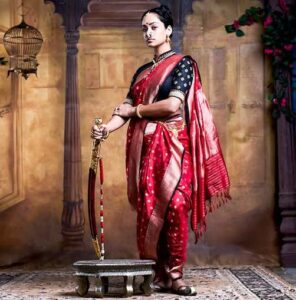
The Nauvari’s origins can be traced to the 17th century during the time of Chhatrapati Shivaji Maharaj, when women were actively involved in defending forts and kingdoms. It wasn’t unusual for them to ride horses, wield swords, or strategize in the absence of men.
Wearing a regular saree wasn’t practical for such tasks. The dhoti-style Nauvari allowed women to run, fight, climb, and ride. It wasn’t stitched for stillness — it was stitched for strength. That’s what makes it more than clothing; it’s a symbol of warriorhood and womanhood.
From Ritual to Routine — Identity in Every Pleat
Today, the Nauvari is worn across religious, cultural, and social functions — by Lavani dancers, brides, Varkari pilgrims, and women during festivals like Gudi Padwa and Ganesh Chaturthi.
But not all Nauvaris are the same. Here’s how they differ:
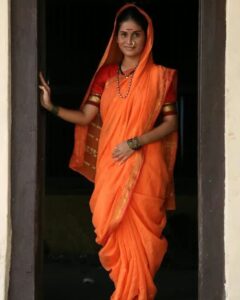
Cotton Nauvaris for daily wear especially among farmers and fisherwomen.
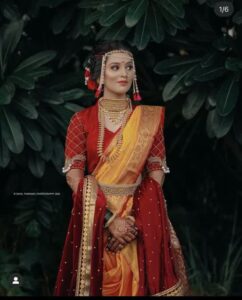
Silk Nauvaris with heavy zari borders for weddings and dance performances.
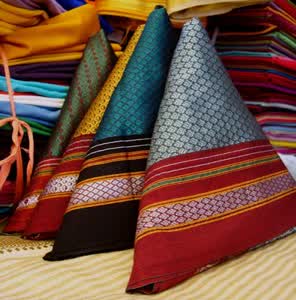
Khun blouses (traditional woven fabric from Maharashtra) are often worn with these sarees.
Each community has a style. Each drape tells a tale.
A Language of Fabric, Motifs, and Borders
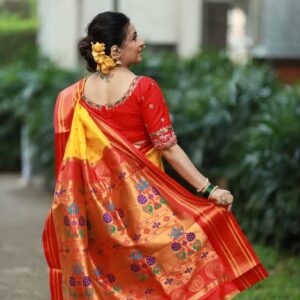
In many Nauvaris, you’ll find influences of Paithani weaving — intricate peacock and mango motifs, vibrant temple borders, and subtle checks and stripes.
Paithani silk Nauvaris are a favorite for weddings.
Narayan Peth Nauvaris from Solapur are known for their elegant borders.
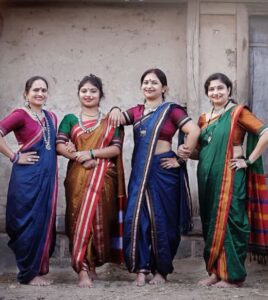
Ilkal Nauvaris feature contrast red borders and are worn in North Karnataka and bordering regions.
Even the motifs carry meaning — lotus for purity, mango for fertility, peacock for royalty.
Drapes of Diversity — Across Regions and Communities
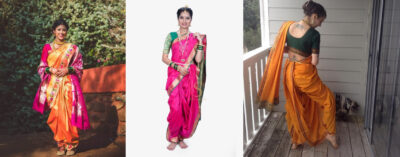
Depending on region, caste, and occasion, the Nauvari takes on different styles:
Kasta Style – Common among working women; functional and easy to walk in.
Brahmani Style – Pallu covers the head; modest and graceful.
Kolhapuri Drape – With unique front pleats and dramatic flow.
Peshwai Drape – Inspired by royal women of the Peshwa era; more structured and layered.
Varkari Style – Simple cotton Nauvaris in pale shades for pilgrimage.
Each drape speaks of geography, religion, or lifestyle — it’s a wearable dialect.
When It Returned to the Spotlight

The 2015 film Bajirao Mastani brought the Nauvari back into the public imagination. When actresses like Deepika Padukone and Priyanka Chopra donned the outfit with armour and jewellery, it felt less like costume and more like a revival.
Fashion designers followed — bringing Nauvari silhouettes to the runway, pairing them with leather belts, boots, and jackets. It found a new audience among brides and stylists, who began blending tradition with edge.
Nauvari Today — Blending Legacy and Innovation
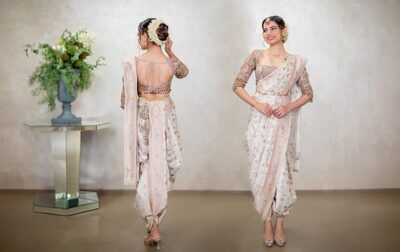
In modern Maharashtra, the Nauvari is seeing a quiet renaissance. Here’s how:
Pre-stitched Nauvaris are now widely available — especially for stage performances.
Fashion brands like Ka-Sha, Chungi, and artisans from Yeola are experimenting with fabrics and dyeing techniques.
Workshops in schools and colleges are teaching draping styles to a new generation
Social media has created a new space — reels of girls dancing in Nauvaris during Navratri, or brides opting for Nauvaris over lehengas.
The saree is no longer seen as “old-fashioned.” It’s seen as heritage.
Passing It On — One Fold at a Time
From grandmothers teaching granddaughters to viral Instagram tutorials — the Nauvari continues to
pass through hands, hearts, and timelines.
In villages, it’s still worn every day. In cities, it’s revived for rituals or photoshoots. But in both places, it holds something deeper: continuity.
Each Nauvari isn’t just a garment — it carries the memory of a lineage, the voice of a community, and the strength of a woman.
Conclusion: It Wears Us Back
The Nauvari has walked through battlefields and weddings, markets and movies. It has changed shapes but not soul. It doesn’t just cover — it celebrates.
To call it “just a saree” is to miss its spirit. Because really — the Nauvari doesn’t follow the woman. It leads her.
References:
Ghurye, G.S. Indian Costume, Popular Book Depot, 1951.
Textile Value Chain – “Regional Sarees of Maharashtra”
The Better India – “The Revival of the Nauvari Saree” by Neha Patil
India Today Travel Plus – “Maharashtra’s Nine-Yard Wonder”
Sarmaya Arts Foundation – Textile Collection Archives




